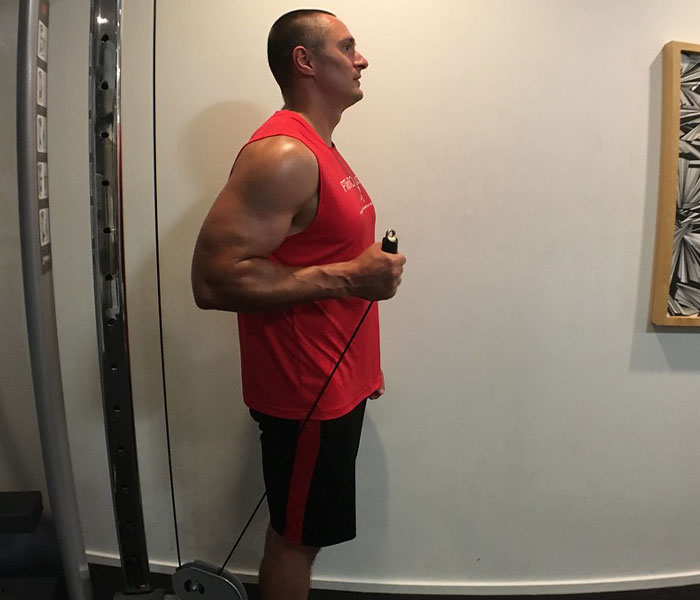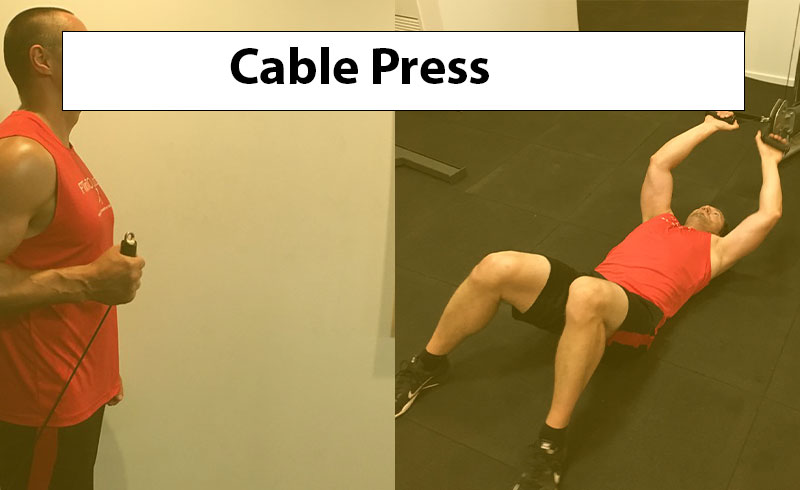If you’re aiming to build a stronger and more defined chest, this exercise might just become your new favorite. Unlike traditional chest presses, the cable chest press utilizes a cable machine, offering a unique twist to your chest workout.
In this comprehensive guide, we’ll explore the benefits, muscle emphasis, correct form, common mistakes, and even some helpful tips to ensure you make the most of your standing cable press workout.
Let’s get into the details and learn how to nail this exercise for maximum gains.

The Cable Chest Press Demystified:
So, what exactly is a cable chest press, and why should you consider adding it to your routine? Think of it as a cousin to the regular chest press and barbell chest press exercises. The difference here is that we’re swapping out the barbell for a cable machine.
Benefits of the Standing Cable Press:
The standing cable press is a fantastic choice for those seeking a chest workout that’s kinder to the shoulder joints compared to traditional bench presses. Standing forces your body to activate the core muscles, adding an element of stability to the movement. This means no more worrying about toppling over during your reps. Additionally, opting for a cable machine with independent weight stacks minimizes any compensatory movements caused by one arm being stronger than the other.
Muscle Emphasis:
This exercise primarily targets the Pectoralis Major, Triceps, and Anterior Deltoid muscles. The secondary muscles engaged include Pectoralis Minor, Latissimus Dorsi, Coracobrachialis, and Serratus Anterior. However, because you’re standing, your entire body gets in on the action. Your Erector Spinae, Abdominals, Glutes, Hamstrings, Calves, and even the intrinsic foot muscles all play a role in maintaining your stability and balance throughout the exercise.
Getting Started:
Stance Matters: Begin by choosing one leg to be in front and the other to be in the back.
Handle Grip: Grab hold of the handles attached to the cable machine. These handles are your connection to the resistance that will challenge your chest muscles.
Perfecting Your Form:
Elbow and Forearm Alignment: The key to an effective cable chest press lies in proper alignment. Your goal is to have your elbows and forearms in the same line as the resistance. This alignment ensures that you’re engaging your chest muscles optimally.
Pressing Motion: Initiate the exercise by pushing the handles forward. As you do this, pay close attention to the alignment of the resistance line along your forearms. This line should run from your wrists all the way back.
Controlled Movement: Emphasize a slow and controlled motion as you press forward. The controlled movement not only enhances muscle engagement but also reduces the risk of injury.
Return Phase: After extending your arms fully, gradually bring the handles back toward your body. Maintain control throughout this motion, resisting the urge to let the weight snap back.
Key Pointers:
- Shoulder Position: Remember, this exercise is all about your chest muscles. Keep your shoulders pulled back and avoid the tendency to hunch forward. Protruding shoulders might shift the focus from your chest to your shoulders.
- Avoid Over-Engaging Shoulders: To ensure you’re targeting your chest muscles effectively, avoid overworking your shoulders. You want the majority of the effort to be concentrated on your chest.
- Mind Your Posture: Maintain a proud chest posture throughout the exercise. Imagine pinching your shoulder blades together and pushing your chest outward to maximize chest muscle activation.
Form Perfection: Tips for Success:
- Neutral Spine: Ensure your spine remains neutral by engaging your abdominals, glutes, and lower body muscles. This helps maintain proper posture throughout the movement.
- Stance: Position one foot slightly in front of the other. This stance enhances your stability and balance during the exercise.
- Elbow and Wrist Alignment: Keep your elbows just below 90 degrees and ensure your wrists and elbows align properly. This alignment supports a smooth and effective movement.
- Palms Push: Push through the palms of your hands to activate the chest muscles efficiently.
- Grounded Feet: Keep both feet planted firmly on the floor. This provides a solid base and prevents any unnecessary movement.
Common Mistakes to Avoid:
- Shoulder Shrugging: Don’t let your shoulders creep up towards your ears during the exercise.
- Jerky Movements: Avoid shifting or jerking your body, as this can compromise your form and effectiveness.
- Grip Width: Refrain from gripping wider than shoulder width, as it can strain your shoulders.
- Lack of Retraction: Ensure your shoulder blades are retracted to prevent tilting and elevation of the humerus. This guards against impingement.
- Handle Position: Aim to bring the cable handles to a position roughly in line with your nipples. Too low or too high can lead to inefficient targeting of muscles.
- Ego vs. Form: Choose a weight that allows you to maintain proper form throughout the exercise, rather than lifting with your ego.
Variations and Alternatives for the Standing Cable Press:
Variations:
- Single-Arm Standing Cable Press: Instead of using both arms simultaneously, perform the exercise one arm at a time. This can help address any muscle imbalances and provide a different challenge to your stability.
- High Cable Chest Press: Adjust the pulleys to a higher position and perform the cable press. This variation targets the upper chest and front shoulders more intensely.
- Low Cable Chest Press: Lower the pulleys to work on the lower chest muscles. This modification helps create a well-rounded chest development.
- Incline Cable Chest Press: Use an adjustable bench to create an inclined angle and perform the cable chest press. This focuses on the upper chest muscles.
Alternatives:
- Barbell Bench Press: The classic barbell bench press is a staple in chest training. It allows you to lift heavier weights and isolate the chest muscles effectively.
- Dumbbell Chest Press: Similar to the barbell bench press, but with dumbbells. This provides a wider range of motion and helps balance strength between both sides of the body.
- Push-Up: A bodyweight exercise that engages the chest muscles along with the shoulders and triceps. It’s a versatile alternative that requires no equipment.
- Machine Chest Press: If you prefer machines, the chest press machine offers stability and targets the chest muscles without the need for balancing.
- Chest Flyes: Use dumbbells or cables to perform chest flyes. This exercise emphasizes stretching and contracting the chest muscles, providing a great isolation movement.
- Pec Deck Machine: This machine specifically targets the chest muscles, mimicking the motion of a flye. It’s a safe and effective alternative to cable presses.
- Resistance Band Chest Press: Attach resistance bands to a stable anchor and perform a pressing motion. This provides resistance throughout the movement and is a convenient home workout option.
Conclusion:
You’re now armed with the knowledge to conquer the standing cable press with confidence. By understanding the benefits, muscles worked, proper form, and pitfalls to avoid, you’re well-equipped to make this exercise a cornerstone of your chest training routine. Embrace the burn, engage your core, and watch your chest muscles flourish as you master the art of the standing cable press. Remember, technique matters, so prioritize form over weight, and let the gains follow naturally.
- Bench Press Calculator - April 22, 2024
- Press to Handstand: Ultimate Step-by-Step Guide - April 22, 2024
- Cable Press (How To Do, Benefits, Targeted Muscles, Alternative) - April 22, 2024

